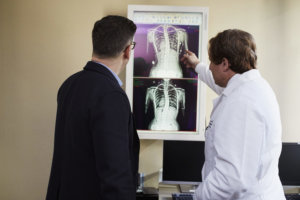DISH — How can a Chiropractor or Physical Therapist help me?
 In the fall of 2019 we a unique patient presentation. The following is a case study of what we found and how we treated the patient.
In the fall of 2019 we a unique patient presentation. The following is a case study of what we found and how we treated the patient.
A 65-year-old retired male presents with neck and upper back pain. The patient claims pain is progressive within the past year and seems to be worse in the AM. He describes the pain as a stiff, ache which inhibits his ability to turn his neck from side to side. He rates his pain on a pain scale of 6/10 with 10 being the worst pain. He states when he is active and as the day progresses his pain can reduce to a 4/10/.
He became aware of his reduced range of motion when he started to have trouble while driving. The pain does not necessarily radiate down his arm but he has felt similar stiffness in his shoulders.
Examination of DISH
Range of motion in the patient’s cervical spine is reduced in all planes, which is not uncommon in patients of this age but there seems to be excessive stiffness.Palpating revealed a bony block feeling within the cervical spine. A movement dysfunction of mention is the patient’s difficulty extending the cervical spine much more than 5 degrees. Motor, reflex, and sensory patterns for C5-T2 were intact and without mention.
Due to the patient’s age, lack of recent radiographs, and signs and symptoms we prescribed radiographs to take a better look at the patient’s bony anatomy.
Upon review of the lateral cervical spine, there is an appearance of calcified tissue or bony outgrowths emanating from the endplates or bottom half of the vertebral bodies. This is clinically described as flowing hyperostosis.
Causes of Diffuse Idiopathic Skeletal Hyperostosis
Diffuse Idiopathic Skeletal Hyperostosis or DISH is caused by the buildup of calcium salts in the ligaments and tendons and hardening and overgrowth of bone. But what causes these to occur is unknown.
This is a form of arthritis affecting tendons and ligaments. Another name for this disease is Forestier Disease. It is most common in males >50 years in age and affects roughly 10% of this population.
Conditions that raise insulin levels such as diabetes and obesity have a correlation with DISH. It is advised to manage these conditions in conjunction with treating your signs and symptoms.
Potential Complications of Diffuse Idiopathic Skeletal Hyperostosis
Ultimately the loss of range of motion is a factor that affects the patient’s activities of daily living. If the calcification becomes severe the patient can have difficulty swallowing. A third complication, once the spine has calcified, is the potential for fracture.
Chiropractic and Physical Therapy Treatment for DISH
Here at the Center For Spine Care and Mobility, we prescribed a combination of physical therapy exercises to strengthen weak muscles while combining chiropractic treatment with Active Release Technique to lengthen the short, tight tissue. Massage therapy was introduced in conjunction with the patient physical therapy.
Care consisted of two visits per week for six weeks. Other forms of treatment include NSAIDS for pain management, and corticosteroids if severe.
In a case such as this where there is no specific cure for this disease the ability to combine modalities and be specific in our treatment protocols gives the patient the best chance for success.
Here we are managing this patient’s condition. If we are successful the patient has an opportunity to live in relatively good health with minimal signs and symptoms.
